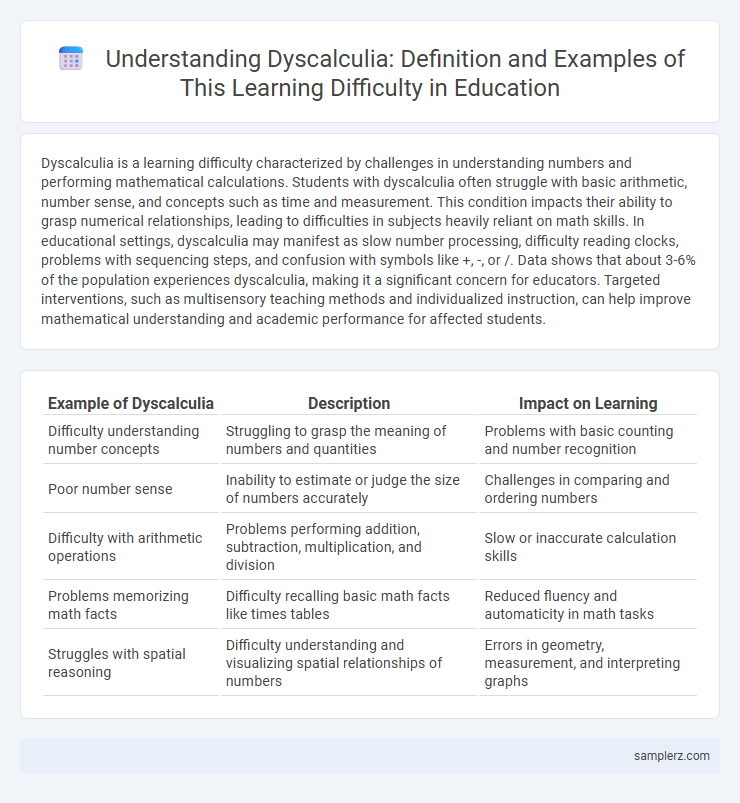Dyscalculia is a learning difficulty characterized by challenges in understanding numbers and performing mathematical calculations. Students with dyscalculia often struggle with basic arithmetic, number sense, and concepts such as time and measurement. This condition impacts their ability to grasp numerical relationships, leading to difficulties in subjects heavily reliant on math skills. In educational settings, dyscalculia may manifest as slow number processing, difficulty reading clocks, problems with sequencing steps, and confusion with symbols like +, -, or /. Data shows that about 3-6% of the population experiences dyscalculia, making it a significant concern for educators. Targeted interventions, such as multisensory teaching methods and individualized instruction, can help improve mathematical understanding and academic performance for affected students.
Table of Comparison
| Example of Dyscalculia | Description | Impact on Learning |
|---|---|---|
| Difficulty understanding number concepts | Struggling to grasp the meaning of numbers and quantities | Problems with basic counting and number recognition |
| Poor number sense | Inability to estimate or judge the size of numbers accurately | Challenges in comparing and ordering numbers |
| Difficulty with arithmetic operations | Problems performing addition, subtraction, multiplication, and division | Slow or inaccurate calculation skills |
| Problems memorizing math facts | Difficulty recalling basic math facts like times tables | Reduced fluency and automaticity in math tasks |
| Struggles with spatial reasoning | Difficulty understanding and visualizing spatial relationships of numbers | Errors in geometry, measurement, and interpreting graphs |
Understanding Dyscalculia: A Common Learning Difficulty
Dyscalculia is a specific learning disability characterized by difficulties in understanding numbers, learning arithmetic facts, and performing accurate calculations despite normal intelligence and adequate instruction. Students with dyscalculia often struggle to grasp basic concepts such as number sense, estimation, and sequencing, which impairs their ability to solve mathematical problems efficiently. Recognizing these core challenges is essential for educators to implement targeted interventions and support strategies that enhance numerical comprehension and improve academic outcomes in math.
Recognizing Early Signs of Dyscalculia in Students
Students with dyscalculia often struggle to understand basic number concepts such as counting, number sequences, and simple arithmetic operations, leading to persistent errors in calculations despite targeted instruction. Early signs include difficulty estimating quantities, confusing mathematical symbols, and challenges in telling time or handling money. Identifying these indicators through screening and classroom observations enables timely intervention and tailored support to improve mathematical learning outcomes.
Real-Life Classroom Examples of Dyscalculia
Students with dyscalculia often struggle to grasp basic number concepts, such as counting objects or understanding place value, which can lead to difficulty completing math problems involving addition or subtraction. In a classroom setting, these students might confuse number symbols, reverse digits, or have trouble following step-by-step instructions for solving problems. Teachers observing frequent errors in arithmetic calculations, inability to estimate quantities, and avoidance of math activities should consider strategies tailored to dyscalculia, like multisensory math instruction or visual aids.
How Dyscalculia Affects Math Learning
Dyscalculia severely impairs the ability to understand numbers, making tasks like counting, recognizing number patterns, and performing basic arithmetic challenging for students. This learning difficulty disrupts the brain's capacity to process numerical information, leading to frequent errors and slower math problem-solving. Students with dyscalculia often struggle with concepts such as number sense, sequencing, and spatial reasoning, which are fundamental for math proficiency.
Challenges Students with Dyscalculia Face
Students with dyscalculia often struggle with understanding number concepts, which impairs their ability to perform basic arithmetic operations like addition, subtraction, and multiplication. Difficulties with spatial reasoning make tasks such as reading charts or aligning numbers challenging, further complicating mathematical problem-solving. These challenges frequently lead to decreased confidence and increased anxiety toward math-related tasks, impacting overall academic performance.
Dyscalculia and Everyday Life: Practical Examples
Dyscalculia significantly impacts everyday life by making tasks like managing money, telling time, and following directions challenging. Individuals may struggle with calculating change at a store, interpreting schedules, or estimating distances while navigating. These practical difficulties highlight the importance of tailored support and strategies to enhance daily functioning for those with dyscalculia.
Identifying Dyscalculia through Student Behaviors
Students with dyscalculia often struggle to understand basic number concepts, frequently confuse mathematical symbols, and have difficulty performing simple calculations despite adequate instruction. Consistent mistakes such as reversing numbers, misreading math problems, and avoiding math-related tasks can indicate the presence of this learning difficulty. Observing these behaviors in classroom settings helps educators identify dyscalculia early and implement targeted interventions.
Case Studies: Dyscalculia in Primary and Secondary Education
Case studies in primary and secondary education reveal that students with dyscalculia often struggle with number sense, basic arithmetic operations, and understanding mathematical concepts, leading to significant learning difficulties. For instance, a report from a secondary school demonstrated that learners with dyscalculia exhibited persistent challenges in problem-solving and spatial reasoning tasks despite targeted interventions. Research highlights the importance of tailored teaching strategies, such as multisensory approaches and technology-assisted learning, to improve mathematical skills and academic outcomes for these students.
Interventions for Students Struggling with Dyscalculia
Interventions for students struggling with dyscalculia include multisensory teaching approaches that integrate visual, auditory, and tactile learning to reinforce number concepts. Utilizing assistive technology such as digital math games and calculators can enhance engagement and comprehension. Structured, repetitive practice combined with personalized instruction helps build foundational math skills and boosts confidence in affected learners.
Supporting Dyscalculic Learners: Tips for Educators
Supporting dyscalculic learners involves using multi-sensory teaching methods that integrate visual aids, manipulatives, and interactive technology to reinforce numerical concepts. Educators should provide step-by-step instructions, allow extra processing time, and use real-life examples to make abstract math ideas more concrete. Regular assessments and personalized feedback help track progress and tailor interventions effectively for students with dyscalculia.

example of dyscalculia in learning difficulty Infographic
 samplerz.com
samplerz.com